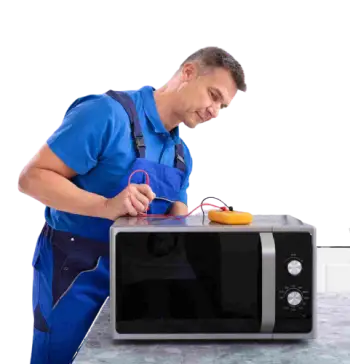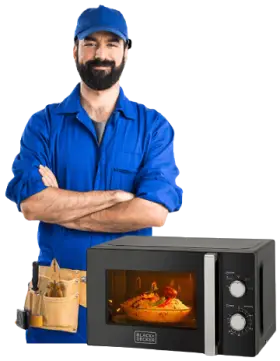Microwaves are most people's go-to’ for heating leftovers. However, if you’re only using your microwave to heat leftovers, then you’re not using it to its fullest potential. And, if you don’t own a microwave oven, then you’re missing out on a very handy and useful home appliance.
Oven Doesn't Heating
Oven not heating food
Oven panel is broken
Oven Runs and Then Stop
Oven Button Do Not Work
Oven Plate Does Not Spin
Sparking Inside Microwave
Oven Door Not Closing Properly
Oven Doesn't Shut Off
Oven Making Noise
Oven Touchpad Doesn't Respond
Oven light fails to turn on.
Oven won’t cook food evenly
The door not closing tightly
Stove sides which are hard to clean
Oven Temperature is Incorrect
Oven Won’t Turn On
Fallen Rack In Your Oven
Delayed Ignition
1.Microwave Ovens
Microwave ovens are a type of oven designed to quickly and efficiently heat a variety of foods. They use high-frequency microwaves – a type of electromagnetic radiation – to heat food in a matter of minutes or even seconds, as the name implies.
2.Toaster Oven
A toaster oven is a countertop appliance that is about the same size as a microwave oven. It's most commonly used for basic cooking tasks like baking bread or pizzas, roasting vegetables, or grilling meat.
3.Conventional Electric Ovens
Coventional gas and electric ovens have a lot in common, such as bottom-up heat transfer and a wide range of options. The primary distinction between the two is the heat source. Conventional gas ovens use a gas flame to cook your food, whereas electric models use a burner element that is powered by electricity, as you might have guessed.
4.Conventional Gas Ovens
Conventional gas ovens are heated from the bottom to the top, usually using a gas flame as the source of heat. In a nutshell, they cook the food from below. They also have a separate top compartment for broiling, though some models allow you to use both top and bottom functions at the same time.
5.Convection Ovens
In recent years, convection ovens have become increasingly popular. After all, they heat food more quickly and evenly, reducing the risk of hot and cold spots. This oven has a fan and exhaust system that circulates the hot air inside the appliance and allows for more consistent heating. Increased air circulation also makes it easier to crisp or brown the outside of your food while keeping the interior moist and juicy.
6.Microwave and Convection Oven
Are you aware that some ovens have both microwave and convection capabilities? These are the most popular items right now, and almost everyone prefers this type of oven. As you can imagine, this automatically entails assistance with both heating and defrosting food items, as well as work for baking and other similar recipes. You have a variety of options to choose from, and you can specify which format you require at any given time during the cooking process.
7.OTG
OTGs, also known as Oven Toaster Grills, are the most common choice in many households. These are much less expensive and more budget-friendly options, as well as useful. The OTGs use an old-fashioned method of cooking, with a filament coil that cooks and heats the food. Grilling, toasting, and even simple baking techniques are all possible with these ovens, as the name implies. The OTGs can also be used to bake cakes and pastries. However, we're confident that convections are a far better option than even cooking and taste.
8.Steam Ovens
Most of you probably haven't heard of steam ovens. As the name implies, steam ovens are specialized and specific types that only assist in steaming food. The steam ovens can be integrated with the kitchen range and other appliances, or they can be placed on the counter. These appliances are particularly useful for steaming vegetables and other meats, which are quick and easy while retaining all of the nutrients and vitamins that would otherwise be lost during cooking. Unfortunately, these aren't widely available and are only available through a few brands in a few countries.
9.Cook and hold oven
This type of oven may no longer be available to most of us. They do, however, still exist in some markets. The cook and hold oven, as its name implies, is ideal for slow-cooking recipes and food. They keep the food safe and help you maintain the right temperature for slow cooking. You also get a storage cabinet for the completed food recipe. The cook and hold ovens are ideal for roasting meats, proofing dough, and roasting vegetables.
10.Deck Ovens
Deck ovens are most likely to be found in shops, restaurants, and small cafes. Deck ovens have large stone shelves that heat up during the cooking process. This heating element is primarily useful in pizzerias and other baking recipes because it is used in the baking and cooking process.
11.Rotisserie Oven
The rotisserie oven is ideal for roasting meat and cooking adventure-based food recipes based on wild inspiration. These belong to the specialized oven category and are used to roast large amounts of meat at once. A spit is also included inside the oven, which acts as a uniform heating element as it rotates during cooking.
12.Conveyor Oven
The conveyor oven functions as a conveyor belt that runs across the appliance, as the name implies. These ovens are ideal for fast cooking and large quantities of meat and vegetables in casual restaurants and cafes. Conveyor ovens, according to many, cut cooking time by at least 25%. They also aid in the retention of moisture on the food's surface, making it appear crisp and fluffy. As a result, the oven is ideal for hot dogs, sandwiches, pizzas, toast, and paninis.
13.Solo microwave oven
It's the most basic type of oven. You can cook and defrost food but you can't grill or bake in it. If something goes wrong with it you can contact our service center to repair it.
14.Grill microwave oven
In this type of oven has radiant heating on top which is good for grilling and roasting and not for cooking. If you face any problem with it call our experts to repair and service it.
Some problems of Oven and solutions
Microwave does not heat: Microwave, not heating is a normal problem, it's because the magnetron in your appliance is broken. It cannot be repaired if it's burnt you have to replace it. Contact our technician they will replace it.
Microwave runs and then shuts off: The main reason for the oven running but shutting off immediately is because of a defective or loose door switch. Our technician will service it.
Microwave touchpad doesn't work:- The button doesn't work because of the defective control panel. it's not repairable it must be replaced. you can contact our customer care.
Oven Light Doesn't Turn On During Operation: It happens when the light bulb is broken or the door safety lock is not working. You have to check the power supply also sometimes there is not enough power supply to use your Oven.
Oven Making Noise: This problem occurs if the fan's bearing is damaged. You need to disconnect the oven from the current supply and then disconnect the fan's connectors or call our technicians to repair it.
Sparking Inside Microwave: When Microwave hits metal objects inside of it that's why the sparks appear. It is safe for the user and dangerous for itself(microwave)
Range Burner Won’t Heat:-Your range burners require electricity to heat up if you have an electric stove. These burners wear out over time and must be replaced. If one of your electric burners isn't working properly.
Gas Burner Won’t Light:-
If the electric ignition on your gas stove fails, you can light the range burners with a match. If the burners aren't lighting and it isn't due to an obvious issue such as a power outage, you should troubleshoot it.
Oven Won’t Heat:-
A faulty igniter (for a gas oven) or the heating element is usually the cause of an oven that won't heat (for an electric oven). If both your gas oven and burners have stopped working, the issue is most likely with the gas line, which will need to be repaired by a professional.
It's not cooking evenly:-
If you toast some bread and notice that some pieces are more toasted than others, your oven isn't heating evenly. You can also try baking a cake or roasting an entire chicken to see if your oven isn't cooking evenly.
Oven temperature is too high or low:-
Excessively hot ovens and ovens that don't get hot enough are both aggravating in their way. It's possible that your oven needs to be re-calibrated if it's not heating up properly. A problem with the temperature sensor or a heating element is also possible.
Oven door is jammed or won’t latch:-
Allow the oven to cool down and power down if the door jams after a cleaning cycle. Consider unplugging the device or shutting down the circuit breaker. Restore power and try the door again after letting it sit for a few minutes.
Oven won’t ignite or draw power:-
A faulty ignitor or electrical problem is usually the cause of an oven that won't turn on at all. If you have a gas oven, check to see if the stovetop burners aren't working as well. If your oven or range does not light, there is most likely a problem with the gas line that will necessitate professional assistance. Consider replacing the ignitor if your range works fine but your oven doesn't. For instructions, consult the owner's manual for your oven.




